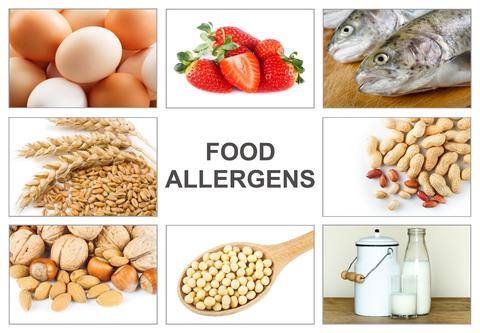Summary
The NIST Food Protein Allergen Program is focused on providing reference materials and methods to improve the connection between the measured protein food allergen and the reported total commodity value. Precise and accurate detection and quantification of food allergens is a crucial component of the allergen management pathway, as practiced by regulatory agencies and food manufacturers. The Food Protein Allergen Program combines the food science expertise of the Chemical Sciences Division with the proteomics expertise of the Biomolecular Measurement Division to expand the intended use of available reference materials and develop new reference materials to support the emerging needs of the food allergen community in the area of protein measurement science.
NIST seeks to develop partnerships within the food allergen management community to develop new reference materials and methods that address present and future measurement needs.
Description

NIST characterizes allergens to support the emerging needs of the food allergen community.
Food allergen management is an increasingly important economic and public health concern; therefore, accurate and reliable allergen measurements are a crucial component of the management pathway. Traditional methods for food allergen detection are based on immunoassay techniques and are linked to a specific commodity (e.g., total milk protein, total egg protein). However, the emergence of mass spectrometry-based platforms has revealed the need for reference materials that support protein-specific measurements. To support the harmonization of food allergen measurements, the new food allergen research effort at NIST is focused on providing reference materials and methods to improve the connection between the measured protein food allergen and the reported total commodity value.
Current food allergen reference materials include a value for total commodity as determined by non-specific approaches, such as total nitrogen measurement, and contain no direct link between the measured food allergen protein(s) and the reported total commodity value. Approximately 18 NIST food reference materials are available that include a reference value for total protein as determined by conversion from a total nitrogen measurement, which potentially could be used to support food allergen measurements. Consequently, claims of traceability for measurement of a specific protein allergen, such as measurements determined by mass spectrometry, to the results of a total nitrogen measurement are invalid. Therefore, adding values for the mass concentrations of specific protein food allergens or their surrogates in existing NIST food reference materials will improve the degree of measurement traceability and provide tools for the user community to validate food protein allergen measurements.
Workshops
- NIST Food Safety Workshop; October 28-31, 2019;
- Food Allergen Technical Session: October 29, 2019
- AOAC 2019 Annual Meeting Community Perspectives of Food Allergen Measurement: September 11, 2019
INTERLABORATORY Study of Milk Allergen Protein
To identify measurement needs and guide the development of reference materials, NIST organized interlaboratory studies to assess measurement equivalence of milk proteins across multiple platforms for simple and complex food samples. Phase I involves the assessment of non-challenging protein samples and Phase II incorporates more complex samples and candidate reference materials.
To learn more about these and related studies, email: nistfoodallergens [at] nist.gov (nistfoodallergens[at]nist[dot]gov)
Presentations
- Phinney, K., Beasley-Green, A., Bunk, D., Phillips, M., O’Connor, G., Martinez-Esteso, M., Scholl, P., Ogura, T. “Challenges of Mass Spectrometry-based Methods for Protein Food Allergens”. 15th International Symposium on Biological and Environmental Reference Materials (BERM-15) Annual Conference, Berlin; September 2018 (Poster Presentation).
- Beasley-Green, A., Bunk, D., Phillips, M., O’Connor, G., Martinez-Esteso, M., Scholl, P., Ogura, T. “Challenges of Mass Spectrometry-based Methods for Protein Food Allergens”. AOAC International Annual Conference, Toronto, CA; August 2018 (Poster Presentation).
- Bunk, D., Beasley-Green, A., Phillips, M., Ogura, T., “Developing Reference Materials for Protein Allergens in Food”. AOAC International Annual Conference, Toronto, CA; August 2018 (Poster Presentation).
- Tran, W., Adom, M.A., Beasley-Green, A., Phillips, M., Bunk, D. “An Interlaboratory Study to Evaluate the Equivalence of Milk Protein Allergen Measurement”. AOAC International Annual Conference, Denver, CO; September 2019 (Poster Presentation).
PUBLICATIONS
- Phillips, M.M., Bunk, D.M., Beasley-Green, A. (2018). “Mid-Year Meeting Special Event: NIST Workshop on Measurement Challenges of the MS-Based Determination of Food Allergens.” Inside Laboratory Management, AOAC International. Jan/Feb 2018 Issue 4.

